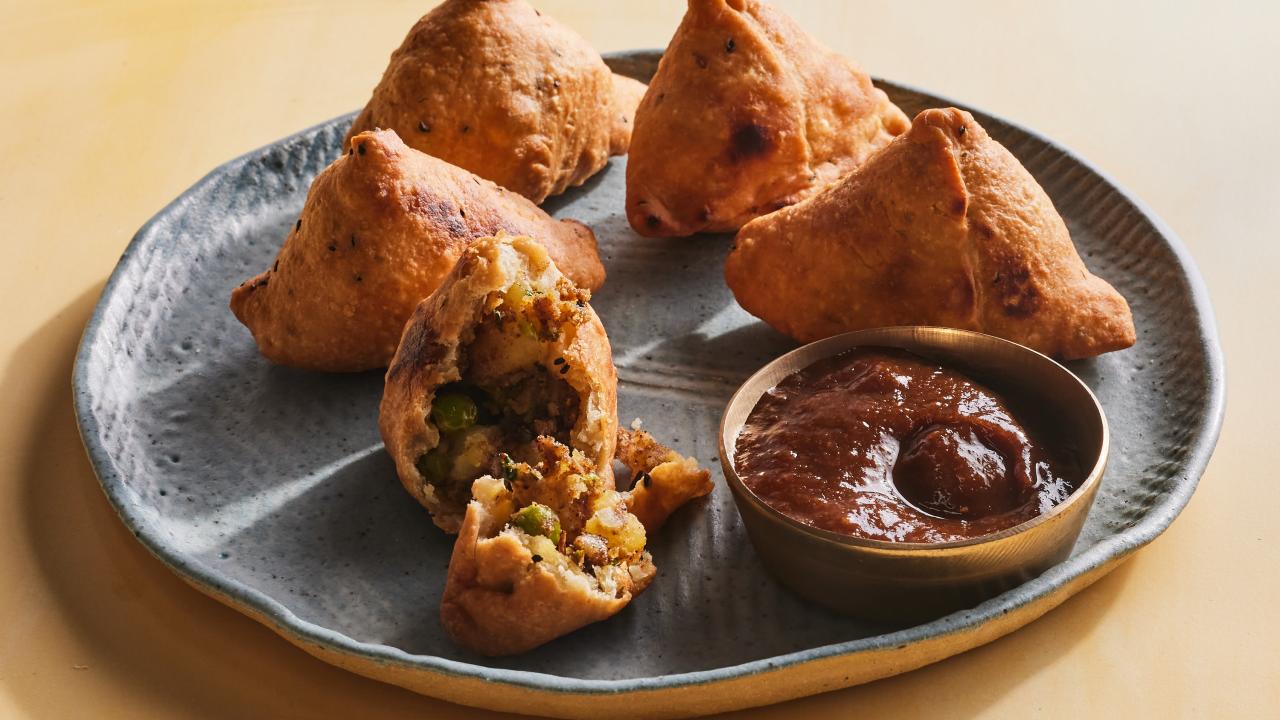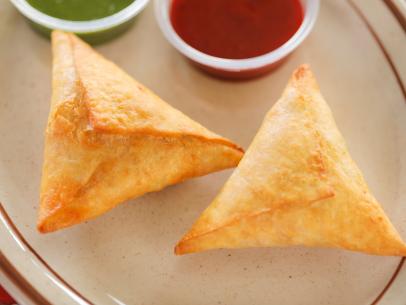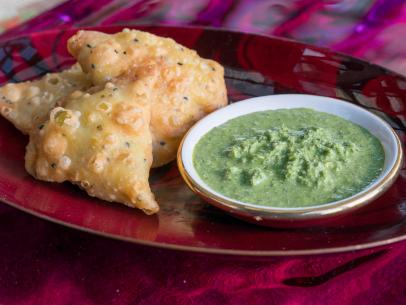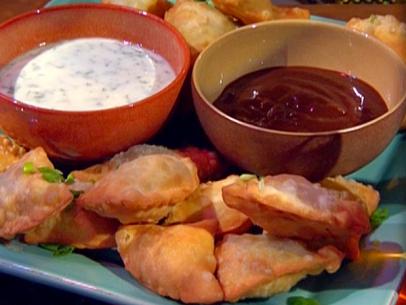Samosas with Tamarind-Date Chutney
- Level: Intermediate
- Total: 2 hr
- Active: 1 hr 45 min
- Yield: 12 large or 16 medium samosas
- Level: Intermediate
- Total: 2 hr
- Active: 1 hr 45 min
- Yield: 12 large or 16 medium samosas
Ingredients
Pastry:
Spice Blend (see Cook's Note):
Filling:
Tamarind-Date Chutney:
Directions
Special equipment:
a deep-frying thermometer- For the pastry: Add the flour, salt and nigella or ajwain seeds to a medium bowl and mix. Add the ghee or oil and mix in with your fingers until the dough looks crumbly. Begin by adding 3 tablespoons of cold water, then add more water a little a time to make a stiff dough. Try to knead the dough as little as possible (think flaky pie crust). Cover with plastic wrap and let it rest for 30 minutes.
- For the spice blend: To roast the spices, heat a small cast-iron skillet or heavy-bottomed pan over medium heat. Add the whole spices: coriander seeds, cumin seeds, fennel seeds, peppercorns, clove, cardamom and cinnamon and roast, shaking the skillet often, until the mixture darkens slightly and becomes toasty and fragrant, 2 to 3 minutes. Remove to a small bowl to cool. Add the amchur powder, red chile powder and turmeric. Once cool, transfer to a grinder or mortar and pestle and grind to a medium-fine grind.
- For the filling: Heat the oil in a large skillet over medium-high heat. Add the cumin seeds and let sizzle until they darken slightly, about 30 seconds Add the peanuts if using and cook until crunchy, about 2 minutes. Add the chiles and ginger and cook, stirring often, until the raw aroma of the ginger goes away, about 1 minute.
- Add the potatoes, peas, roasted spice blend and 1 1/2 teaspoons salt and cook until the peas soften and the mixture is well mixed and seasoned, about 3 minutes. Add the cilantro if using. Add salt to taste, amchur for additional tang and red chile powder for spice.
- To assemble and fry the samosas: Pour enough oil into a large Dutch oven or wide heavy-bottomed pot to come up the sides about 3 inches. Place over medium heat and heat until a deep-frying thermometer inserted in the oil registers 340 degrees F.
- While the oil is heating, divide the dough into 6 equal pieces and roll each piece into a ball (a kitchen scale is helpful here but not necessary). For smaller samosas, you can divide the dough into 8 balls. Cover all but 1 ball with a damp cloth or plastic wrap. Flatten the uncovered ball into an oval patty. Lightly brush with oil and roll the patty into a thin oval (8 to 9 inches long and 5 to 6 inches wide). Cut in half widthwise into 2 semicircles.
- Set a small bowl of water beside you. Working with one semicircle at a time, fold over one end of the straight edge halfway toward the rounded edge. Using a fingertip, lightly wet the outside edge with a little water as well as the inner edge of the other half of the straight side. Then fold the other half up and overlapping the wet sides, about 1/4 inch, to form a cone. Press the edges together to form a seal. Hold the cone in one hand, pinch the seam again to make sure it’s sealed and fill it with 2 tablespoons of the potato filling. Make a little pleat opposite of the sealed edge by pinching it over about 1/4 inch. This is the backbone of the samosa and will help it stand. Wet the inside of the rounded edge and fold it over the filling to enclose it. Press the edges together to seal. Repeat with a second dough ball and some of the filling to make 4 samosas.
- Double-check that the oil temperature is 340 degrees F (it's important for the oil to be medium hot; if it's too hot, the outside of the samosas will brown too quickly, while the inside dough will not be cooked enough and the samosas won't crisp up). Gently slip in the 4 samosas and fry until golden brown and crispy, about 10 minutes. If the samosas haven't browned by then, increase the temperature to 360 degrees F and cook, turning over as needed, until golden brown. Using tongs or a slotted spoon, transfer to a paper towel-lined baking sheet to drain.
- While the samosas are frying, shape and fill 4 more samosas, then repeat until all the samosas are shaped, filled and fried. Serve immediately with Tamarind–Date Chutney.
Tamarind-Date Chutney:
- Stir together the seedless tamarind, date paste, jaggery, cumin powder, red chile powder, ginger powder, fennel powder, black salt, 1/4 teaspoon kosher salt and 1 cup water in a small saucepan. Bring to a boil, then lower the heat to medium low so the sauce is simmering. Cook, uncovered and stirring occasionally, until the sauce is thickened, about 15 minutes; when you dip a spoon into the sauce and run your finger across the back of it, it should hold a line. Taste and add more salt or jaggery if needed. Remove from the heat and strain. Allow to cool to room temperature. Transfer to an airtight glass jar and refrigerate.
Cook’s Note
Ajwain or carom seeds are traditionally used in making Punjabi samosas; they have a strong flavor which is somewhat of an acquired taste. In Bengal they use nigella seeds instead and I like them much more. The wrap is much flakier and tastier when you use ghee. If you'd prefer not to make the spice blend, you can substitute 1 tablespoon curry powder plus 2 teaspoons amchur powder (raw mango powder) as a shortcut. To substitute it when making the filling, add the peas and curry powder and cook until the raw smell of the curry dissipates, about 3 minutes. Add the potatoes, amchur and salt and cook until the mixture is well mixed and seasoned, about 2 minutes, then proceed with the recipe. The addition of peanuts gives the samosas a really nice crunch. Again, they are very prevalent in Bengali samosas and I would highly recommend them. It’s important to use a wet block of the seedless tamarind pulp and not tamarind paste for this recipe. Most of the brands are not 100% seedless and often have a skin, hence it is best to strain the mixture. Traditionally this chutney is made with jaggery, an unrefined sugar. If you can only find jaggery blocks and not powdered jaggery, it should be finely chopped.
Looking for Something Else?
Related Pages
- Mediterranean Chicken Samosas with Apple Cumin...
- Raisin and Tamarind Chutney Recipe
- Samosas with Tamarind Sauce Recipe
- Baked Samosas with Mint Chutney Recipe
- Cauliflower Chaat Salad with Tamarind Date...
- Jalebi Recipe
- Thanksgiving Samosas with Green Chutney Recipe
- Herbed Desai Vada with Cilantro Chutney Recipe
- Cassava Ball with Tamarind Sour Recipe



































